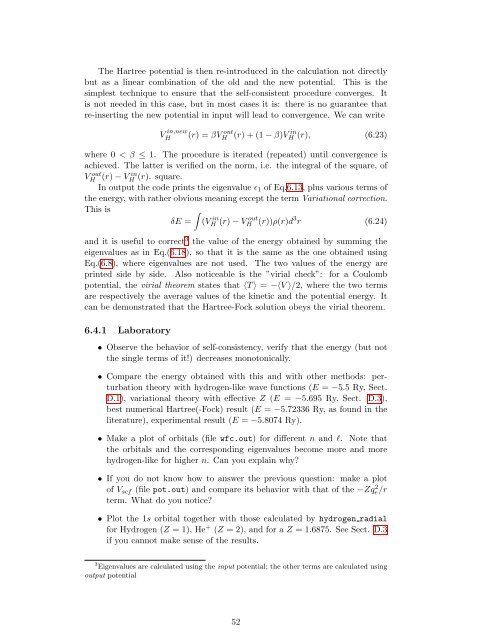Numerical Methods in Quantum Mechanics - Dipartimento di Fisica
Numerical Methods in Quantum Mechanics - Dipartimento di Fisica
Numerical Methods in Quantum Mechanics - Dipartimento di Fisica
Create successful ePaper yourself
Turn your PDF publications into a flip-book with our unique Google optimized e-Paper software.
The Hartree potential is then re-<strong>in</strong>troduced <strong>in</strong> the calculation not <strong>di</strong>rectly<br />
but as a l<strong>in</strong>ear comb<strong>in</strong>ation of the old and the new potential. This is the<br />
simplest technique to ensure that the self-consistent procedure converges. It<br />
is not needed <strong>in</strong> this case, but <strong>in</strong> most cases it is: there is no guarantee that<br />
re-<strong>in</strong>sert<strong>in</strong>g the new potential <strong>in</strong> <strong>in</strong>put will lead to convergence. We can write<br />
V <strong>in</strong>,new<br />
H<br />
(r) = βVH<br />
out (r) + (1 − β)VH <strong>in</strong> (r), (6.23)<br />
where 0 < β ≤ 1. The procedure is iterated (repeated) until convergence is<br />
achieved. The latter is verified on the norm, i.e. the <strong>in</strong>tegral of the square, of<br />
VH<br />
out (r) − V<br />
<strong>in</strong><br />
H (r). square.<br />
In output the code pr<strong>in</strong>ts the eigenvalue ɛ 1 of Eq.6.13, plus various terms of<br />
the energy, with rather obvious mean<strong>in</strong>g except the term Variational correction.<br />
This is<br />
∫<br />
δE = (VH <strong>in</strong> (r) − VH out (r))ρ(r)d 3 r (6.24)<br />
and it is useful to correct 3 the value of the energy obta<strong>in</strong>ed by summ<strong>in</strong>g the<br />
eigenvalues as <strong>in</strong> Eq.(6.18), so that it is the same as the one obta<strong>in</strong>ed us<strong>in</strong>g<br />
Eq.(6.8), where eigenvalues are not used. The two values of the energy are<br />
pr<strong>in</strong>ted side by side. Also noticeable is the ”virial check”: for a Coulomb<br />
potential, the virial theorem states that 〈T 〉 = −〈V 〉/2, where the two terms<br />
are respectively the average values of the k<strong>in</strong>etic and the potential energy. It<br />
can be demonstrated that the Hartree-Fock solution obeys the virial theorem.<br />
6.4.1 Laboratory<br />
• Observe the behavior of self-consistency, verify that the energy (but not<br />
the s<strong>in</strong>gle terms of it!) decreases monotonically.<br />
• Compare the energy obta<strong>in</strong>ed with this and with other methods: perturbation<br />
theory with hydrogen-like wave functions (E = −5.5 Ry, Sect.<br />
D.1), variational theory with effective Z (E = −5.695 Ry, Sect. D.3),<br />
best numerical Hartree(-Fock) result (E = −5.72336 Ry, as found <strong>in</strong> the<br />
literature), experimental result (E = −5.8074 Ry).<br />
• Make a plot of orbitals (file wfc.out) for <strong>di</strong>fferent n and l. Note that<br />
the orbitals and the correspond<strong>in</strong>g eigenvalues become more and more<br />
hydrogen-like for higher n. Can you expla<strong>in</strong> why?<br />
• If you do not know how to answer the previous question: make a plot<br />
of V scf (file pot.out) and compare its behavior with that of the −Zq 2 e/r<br />
term. What do you notice?<br />
• Plot the 1s orbital together with those calculated by hydrogen ra<strong>di</strong>al<br />
for Hydrogen (Z = 1), He + (Z = 2), and for a Z = 1.6875. See Sect. D.3<br />
if you cannot make sense of the results.<br />
3 Eigenvalues are calculated us<strong>in</strong>g the <strong>in</strong>put potential; the other terms are calculated us<strong>in</strong>g<br />
output potential<br />
52
















